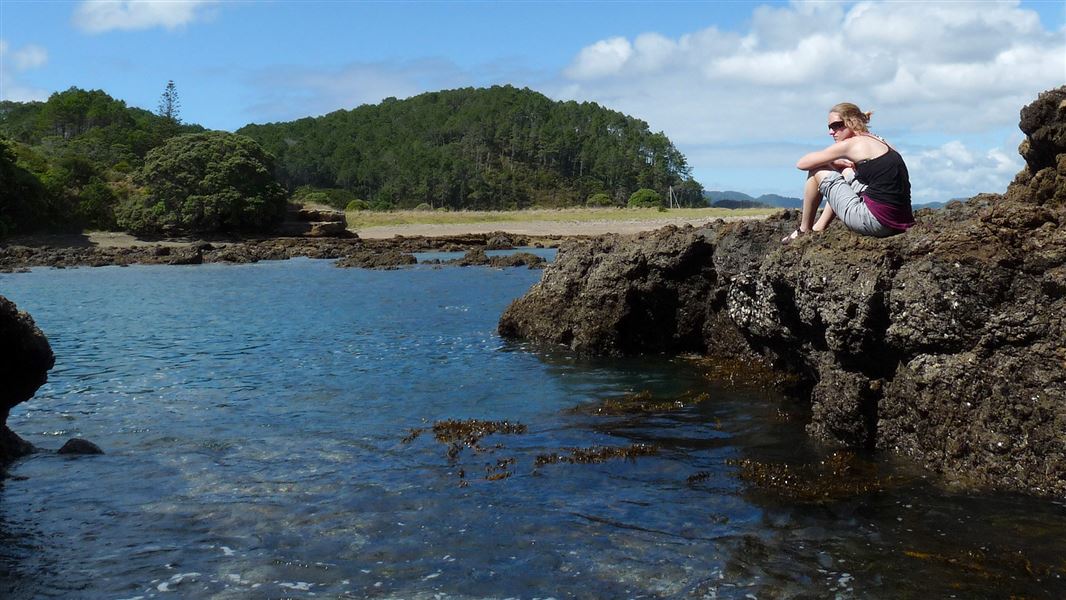Motuarohia Island Recreation Reserve is situated in the eastern part of Te Pēwhairangi (Bay of Islands) Marine Mammal Sanctuary. There are restrictions you need to follow while travelling in Te Pēwhairangi (Bay of Islands) Marine Mammal Sanctuary.
Restrictions while you're in Te Pēwhairangi (Bay of Islands) Marine Mammal Sanctuary.
Once out on the water from Paihia or Russell, the first island you see is Motuarohia Island, distinguished by its two glorious lagoons – the most photographed scene in the Bay.
The channel between Motuarohia Island and Moturua Island is a marine mammal safe zone.
Restrictions for vessels in the safe zones.
The reserve is part of the Bay of Islands Maritime and Historic Park.
- Walks in this area can include sections near steep cliffs. Supervise children when near cliffs and keep on the track at all times.
- Bay of Islands Maritime and Historic Park bylaws apply.
- Rubbish is not collected – take your rubbish with you. There may be rubbish facilities during summer.
- Camping in the Bay of Islands is only available on Urupukapuka Island.
This reserve is within Te Pēwhairangi (Bay of Islands) Marine Mammal Sanctuary.
- Motukawanui Island Scenic Reserve is not within Te Pēwhairangi (Bay of Islands) Marine Mammal Sanctuary.
Water safety
If you plan to enjoy the water, learn how to stay safe when swimming, boating and fishing.
Conservation
In 1979, the central section of the island came under the care of the Department of Conservation.
The island is now pest free, thanks to Project Island Song. As part of an ongoing restoration of the island, whitehead/popokotea have been released. These 'canaries of the forest' can be heard and occasionally seen across Motuarohia. Other conservation work includes looking after resident North Island brown kiwi and NZ dotterel nest protection during the breeding season.
Topography
The topography of Motuarohia ranges from steep coastal cliffs which face the open sea to the north and west, with headlands dissected by moderately steep gullies on its southern side. Flat lat surrounds a lagoon area on the southern side of Motuarohia.
Vegetation
There are kikuyu grass flats, kanuka/native shrub hardwood forest and extensive stands of maritime pine (Pinus pinaster) with a regenerating understorey of native shrub hardwoods which are mainly hangehange and coprosma spp. Coastal cliff communities are extensive with pohutukawa and the coastal tussock (Chionachloa bromoides). Stands of maritime pine were originally grown for the extraction of turpentine.
Extensive planting of native coastal species has resulted in native forest regeneration in areas of felled to waste pine forest on the western end of the island.
Habitation
There are permanent residents on the island in at least one of the 9 dwellings on private land, and there are multiple ancillary buildings.
Public conservation land: Motuarohia Island Recreation Reserve 19.488 ha
Private land: 43.914 ha
Total Area: 63.402
Stop kauri disease and protect kauri
- Scrub all soil off shoes and gear.
- Use cleaning stations.
- Always stay on the track.
Check you are pest-free
Check, clean, and seal your gear to ensure you don't bring pests, soil, and seeds.
DOC Customer Service Centre
| Phone: | 0800 275 362 |
| Email: | bayofislands@doc.govt.nz |
| Address: | Pewhairangi / Bay of Islands Office |
